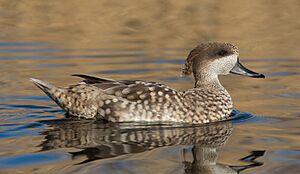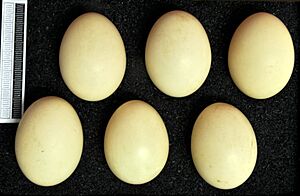Marbled duck facts for kids
The marbled duck or marbled teal (Marmaronetta angustirostris) is a type of medium-sized duck. You can find it in southern Europe, northern Africa, and parts of western and central Asia. Its scientific name, Marmaronetta angustirostris, tells us a bit about it. Marmaros is Greek for 'marbled,' and netta means 'duck.' Angustus is Latin for 'narrow' or 'small,' and -rostris means 'billed,' referring to its beak.
Quick facts for kids Marbled duck |
|
|---|---|
 |
|
| Conservation status | |
| Scientific classification | |
| Genus: |
Marmaronetta
|
| Species: |
angustirostris
|
Contents
Where Marbled Ducks Live
Marbled ducks used to breed all over the Mediterranean area. Now, they only breed in a few places. These include southern Spain, southern Italy, northwest Africa, and the wider Levant region.
Further east, you can find them in the Mesopotamian Marshes in southern Iraq and in Iran. The Shadegan Marshes in Iran are especially important for these ducks. They also live in small groups in Armenia, Azerbaijan, southern European Russia, western India, and western China.
These ducks often move around, so they are called 'nomadic.' Some birds travel from their breeding areas to the Sahel zone, south of the Sahara, during winter.
Marbled Duck Habitat
Marbled ducks like to breed in places with temporary, shallow water. This water can be fresh, slightly salty (brackish), or alkaline. They prefer areas with lots of plants along the shore, especially in regions that are otherwise quite dry.
They might also breed in lagoons near the coast or along slow-moving rivers. Sometimes, they use man-made water bodies like reservoirs.
Marbled Duck Reproduction
Female marbled ducks usually lay about 12 eggs. They build their nests close to the water's edge, hidden by thick plants. Most nests are on the ground. However, some are built higher up among reeds or on small huts made from reeds.
Marbled ducks are social birds. They often stay in groups, even when they are nesting. Outside of the breeding season, their flocks are usually small. But sometimes, very large groups gather in winter. The biggest known winter gathering was in Khuzestan, Iran.
In 2011, experts counted a huge flock of marbled ducks in the Mesopotamian Marshes of Iraq. There were at least 40,000 birds in that single group!
What Marbled Ducks Look Like and Eat
A marbled duck is about 39 to 42 centimeters (15 to 17 inches) long. Adult ducks are a pale sandy-brown color. They have blurry off-white spots and a dark patch around their eyes. Their head feathers look a bit shaggy.
Female ducks are usually a little smaller than males, but they look very similar. Young ducks look like the adults but have more off-white spots. When they fly, their wings look pale and do not have any special patterns.
Marbled ducks mostly find food in shallow water. They dabble or tip their bodies upside down to reach food. Adult ducks mainly eat seeds from plants like Scirpus and Ruppia. They also eat many small water creatures like insect larvae, tiny crustaceans, and even ants. They also eat green plants such as Potamogeton.
Their stomachs have a special part called a gizzard that helps them break down seeds. Their beaks have tiny comb-like parts called lamellae. These help them filter tiny living things, like zooplankton, from the water. Young marbled ducks mostly eat small water creatures. They can eat tiny seeds, but they don't have a large enough gizzard to break down bigger seeds like the adults do.
Protecting Marbled Ducks
The marbled duck is considered 'near threatened' by the IUCN. This means their population is getting smaller. The main reasons for this are that their homes (habitats) are being destroyed and they are sometimes hunted.
The marbled duck is one of the birds protected by the Agreement on the Conservation of African-Eurasian Migratory Waterbirds (AEWA). This agreement helps protect birds that travel long distances between Africa, Europe, and Asia.




